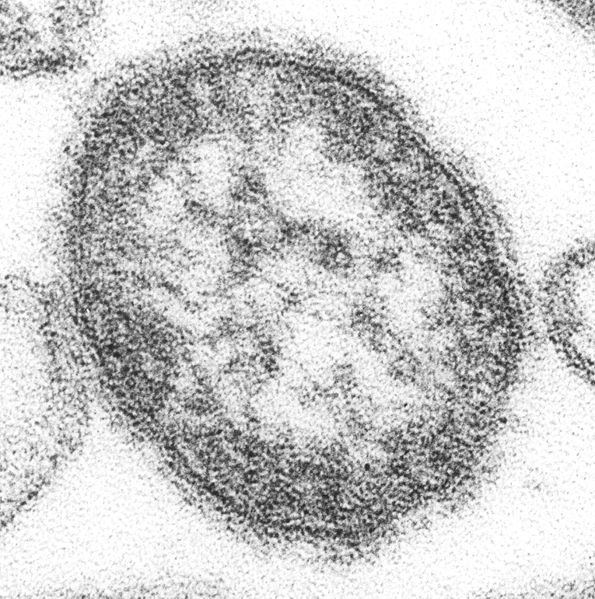Measles virus
| Measles | ||||||||||||
|---|---|---|---|---|---|---|---|---|---|---|---|---|
 Measles virus electron micrograph
| ||||||||||||
| Virus classification | ||||||||||||
|
Editor-In-Chief: C. Michael Gibson, M.S., M.D. [1]
|
Measles Microchapters |
|
Diagnosis |
|---|
|
Treatment |
|
Case Studies |
|
Measles virus On the Web |
|
American Roentgen Ray Society Images of Measles virus |
Overview
Measles virus (MeV) is a single-stranded, negative-sense, enveloped RNA virus of the genus Morbillivirus within the family Paramyxoviridae. Humans are the natural hosts of the virus; no animal reservoirs are known to exist.
Microbiology
The measles virus is the cause of measles, an infection of the respiratory system. Symptoms include fever, cough, runny nose, red eyes and a generalized, maculopapular, erythematous rash. The virus is highly contagious and is spread by coughing and sneezing via close personal contact or direct contact with secretions.
Replication cycle
Entry
The measles virus has two envelope glycoproteins on the viral surface - hemagglutinin (H) and membrane fusion protein (F). These proteins are responsible for host cell binding and invasion. Three receptors for the H protein have been identified to date: complement regulatory molecule CD46, the signaling lymphocyte activation molecule (SLAM) and the cell adhesion molecule Nectin-4.[1]
Evolution
The measles virus evolved from the formerly widespread rinderpest virus, which infects cattle.[2] Sequence analysis has suggested that the two viruses most probably diverged in the 11th and 12th centuries, though the periods as early as the 5th century fall within the 95% confidence interval of these calculations.[2]
Other analysis has suggested that the divergence may be even older because of the technique's tendency to underestimate ages when strong purifying selection is in action.[3] There is some linguistic evidence for an earlier origin within the seventh century.[4][5] The current epidemic strain evolved at the beginning of the 20th century—most probably between 1908 and 1943.[6]
Genotypes
The WHO currently recognises 8 clades of measles (A–H). Subtypes are designed with numerals – A1, D2 etc. Currently a total of 23 subtypes are recognised. The sequencing of the 450 nucleotides that code for the C‐terminal 150 amino acids of N are the minimum amount of sequence data required for genotyping a measles virus isolate. The genotyping scheme was introduced in 1998 and extended in 2002 and 2003.
The major genotypes differ between countries and restatus of measles circulation within that country or region. Indigenous transmission of measles virus was interrupted in the United States and Australia by 2000 and the Americas by 2002.
- Measles virus (MV) is an enveloped, nonsegmented negative-stranded RNA virus of the Paramyxoviridae family, genus Morbillivirus.
- It is 100–200 nm in diameter, with a core of single-stranded RNA, and is closely related to the rinderpest and canine distemper viruses.
- Two membrane envelope proteins are important in pathogenesis:
- F (fusion) protein, which is responsible for fusion of virus and host cell membranes, viral penetration, and hemolysis.
- H (hemagglutinin) protein, which is responsible for adsorption of virus to cells.
- There is only one antigenic type of measles virus. Although studies have documented changes in the H glycoprotein, these changes do not appear to be epidemiologically important (i.e., no change in vaccine efficacy has been observed).
- Measles virus is rapidly inactivated by heat, light, acidic pH, ether, and trypsin. It has a short survival time (less than 2 hours) in the air or on objects and surfaces.
References
- ↑ Lu G, Gao GF, Yan J (2013) The receptors and entry of measles virus: a review. Sheng Wu Gong Cheng Xue Bao 29(1):1–9
- ↑ 2.0 2.1 Furuse Y, Suzuki A, Oshitani H (2010). "Origin of measles virus: divergence from rinderpest virus between the 11th and 12th centuries". Virol. J. 7: 52. doi:10.1186/1743-422X-7-52. PMC 2838858. PMID 20202190.
- ↑ Template:Cite doi
- ↑ Griffin DE (2007). "Measles Virus". In Martin, Malcolm A.; Knipe, David M.; Fields, Bernard N.; Howley, Peter M.; Griffin, Diane; Lamb, Robert. Fields' virology (5th ed.). Philadelphia: Wolters Kluwer Health/Lippincott Williams & Wilkins. ISBN 0-7817-6060-7.
- ↑ McNeil, W. (1976). Plagues and Peoples. New York: Anchor Press/Doubleday. ISBN 0-385-11256-4.
- ↑ Pomeroy LW, Bjørnstad ON, Holmes EC (February 2008). "The evolutionary and epidemiological dynamics of the paramyxoviridae". J. Mol. Evol. 66 (2): 98–106. doi:10.1007/s00239-007-9040-x. PMC 3334863. PMID 18217182.